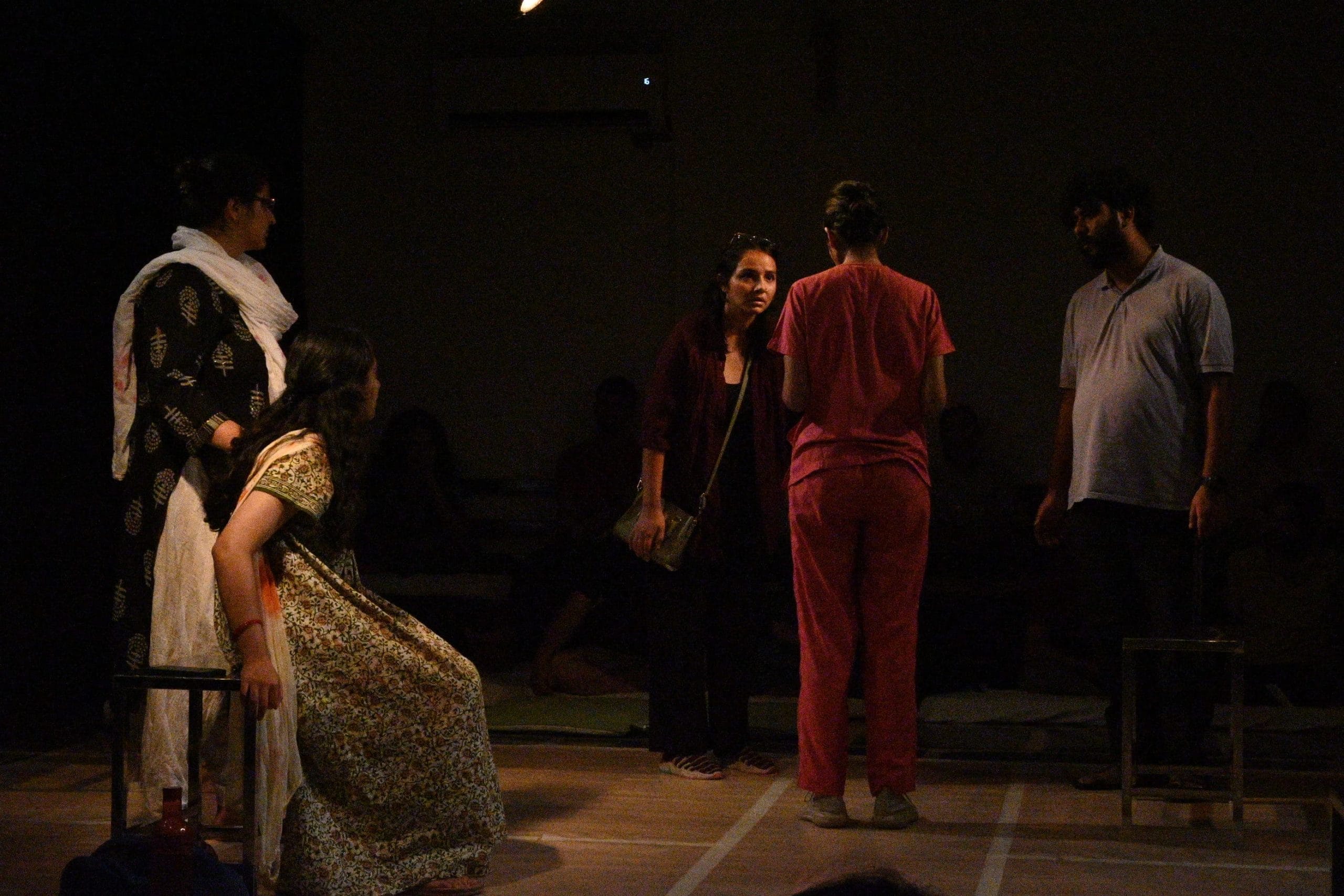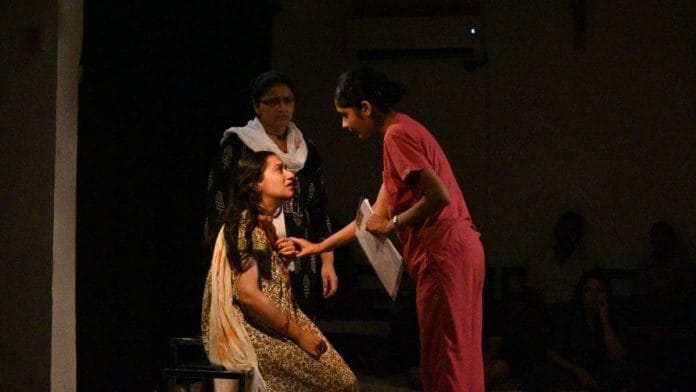New Delhi: In a damp green hospital room wafting with the sharp smell of Dettol, four anxious characters struggle to get comfortable on shiny, rickety steel benches. Each waits for a loved one to recover, while choking on their grief—a grief made worse by the harsh realities of the Indian medical system and the loneliness of their shared waiting room.
Third Space Collective’s ‘Usar’ (sterile) isn’t a regular play in the Delhi theatre circuit. There’s no stage, no ornate props and no plot. It’s a ‘devised’ play—actors aren’t married to their scripts, and improvisation is king. The play examines four medical emergencies and the human turmoil that accompanies them. The waiting room is the only ‘set’. Silence and stillness are characters by themselves. In that, it is very Waiting for Godot in its ambition.
First commissioned by the Sanhita Manch in 2023 and revived in July 2024 with a different name, Usar was inspired by V Balakrishnan’s play Exit Wounds. The decision to make it was fuelled by director Neel Sengupta’s personal experience with loss, and how quickly people moved on from the Covid-19 pandemic.
Performed recently in the basement of the Lilanoor Centre for Voice and Music in South Extension, Usar explores the “collective grief” of four people from across India’s caste, class, and religious spectrum. It taps into the caretaker’s experience—the anxiety of waiting for someone to get better, and the inability to form close bonds with fellow waiters despite understanding their plight.
“Hospitals—and funeral homes—are the only spaces where class and caste divide go away because everybody has to stand in,” Sengupta told ThePrint.

Some scenes are counter-intuitive. The long uncertain wait also makes some people emotionally exasperated. In one powerful scene, one of the four characters, who happened to wheel an accident victim, recalls his own dilemma. “Doctors say that he will either die tonight or linger for months. But my office has given me an ultimatum—return by Monday or find another job. Better if he dies today,” he smirks
Almost nobody in the audience was scrolling their phones or shifting in their seats. They were glued to every unfolding dialogue and scene.
Usar revolves around four individuals: Parveen (Dhwani Vij), a middle-aged Muslim woman striving to save her minor son from Leukaemia; Prasad (Noel Sengupta), an immigrant stuck waiting for his roommate to recover from an accident because his family won’t help; Nimmi (Saumya Jakhmola), an independent urban woman grappling with her sister’s suicide attempt, and Nutan (Ravleen Kaur Chawla) an Anganwadi worker and Tughlaqabad resident whose husband was shot by the police for protesting forced evictions by the government. There’s also a nurse (Purnabha Chaturvedi), who represents the hospital administration.
“We wanted to explore how strangers develop relationships in isolating spaces, and respond to crises that are perhaps bigger than theirs,” said the play’s associate director, Tanishq Pant. “Our characters were all alone, put in a box, and forced to work together and find some humaneness within them.”
Also read: Mirza Ghalib returns. Uses Instagram, attends Ambani wedding, told to ‘go to Pakistan’
‘A treat for actors’
Be it floods, earthquakes or riots, history shows that the community has always found a way to come together, stressed Sengupta. “We talk about it, listen to each other, share each other’s stories. But post-pandemic, we just pretended everything was okay, and we moved on,” he said, adding that as a company, they “wanted to collectively articulate and process” this trauma.
Intrigued by the premise and the space Exit Wounds was exploring, the makers decided to take some characters from the original text, keep some existing conflicts, and create something entirely new. And they made it through the “rigorous dramaturgical process” of devising.
“I wanted a piece where the performers will take the play through. So, the design is based on the performers. Everything is performance-heavy. It’s an acting piece, to be honest. Difficult, but also a treat for actors,” said Sengupta.
It is evident from how the play was performed. The actors brought their characters to life by creating their own backstories and incorporating realistic moments such as phone conversations and mindless reel swiping. Attention to detail was crucial. Nutan carried two cheap smartphones—her husband’s and hers—giving the viewer an instant glimpse into her life of hardship and the suddenness of her ordeal.
Parveen, like a typical Indian mother, was more concerned about keeping everyone else in a positive mood. In one scene, she whipped out a pack of digestive biscuits for an inconsolable Nutan, even massaging her back to soothe her.

“I have grown up seeing women like Parveen—my mother, my grandmother, my aunts. Witnessing them felt both tragic and warm and fuzzy,” said Dhwani Vij, who played Parveen. She recalled an anecdote from her childhood, when her aunt, who was hospitalised with a broken leg, still took the time to make sure Vij ate.
“I found it very normal back then. But as I developed this character for the play, I realised that women are forever taught to only take care of everyone else. And we don’t question it.”
Also read: Theatre is therapy—When MK Raina put on a play with Muslim and Kashmiri Pandit children
Creating an experience
Why a basement? Sengupta’s choice of a damp and suffocating venue was deliberate. Everything—from the smell to the temperature to the seating arrangement—was designed to immerse the audience in an unsettling situation. The floor was mopped with antiseptic liquid to evoke the smell of a hospital, the ACs were cranked up to mimic an uncomfortable waiting room, and the audience was seated on either side of the performance area to create a fly-on-the-wall experience.
“The room is cold, it’s so gloomy, there’s no sunlight, people are so hassled. What happens to your body in such a situation? We tried exploring that with our bodies,” said Saumya Jakhmola, who played Nimmi. The actors walked in sharp lines, understood their backbones, and explored sitting in different ways, she added.
Moreover, it’s a play shouldered by silences. “They’re sometimes a bored stretch of time, sometimes a cry for help, and sometimes numb grief,” said Ravleen Kaur Chawla, who played Nutan.
According to Sengupta, Usar wouldn’t have worked on the typical stage of a typical auditorium.
“This play has no plot. It’s atmospheric, an experience. It’s important that the audience is able to hear the breath of the actor…almost as if they’re waiting together”.
Sengupta’s instinct was right, and it paid off. According to 28-year-old Gurman Singh, who teaches at Delhi University and recently attended the play, the narrative, and the set itself, were handled in a very “understated and economical” way.
“It allowed the play’s emotional weight to slowly reveal itself.”
(Edited by Theres Sudeep)






